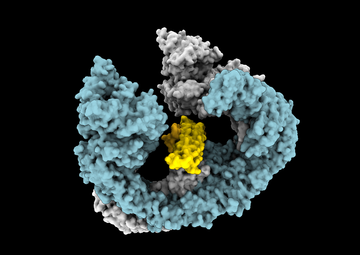
BIRC6 (blue/grey) - a giant ubiquitin ligase and essential regulator of cell death is antagonised by SMAC (yellow)
Latest research from the group of Paul Elliott has uncovered how BIRC6 (a giant ubiquitin ligase) protects cells from death and how this can be antagonised.
Cell survival and death are a finely balanced act, important for normal development of multicellular organisms. Many cancer cells switch off cell death mechanisms and upregulate proteins that normally prevent unwanted cell death thus ensuring their survival. Inhibitor of Apoptosis Proteins (IAPs) are a family of proteins that prevent untimely cell death.
Research from the Elliott Lab published in Science, uses single particle cryo-EM and detailed biochemical analyses to uncover how the giant IAP BIRC6 keeps cells alive through counteracting the function of caspases – enzymes that execute cell death. Furthermore, the study reveals how this cell guardian function of BIRC6 is antagonised by SMAC once cells become committed to dying. These findings pave the way for development of small molecules targeting BIRC6 in cancer cells to restore cell death.
“It’s been nearly 20 years since BIRC6 was first identified as a regulator of cell death but owing to its huge size (nearly 5000 amino acids) technical challenges prevented a detailed structural and biochemical understanding of BIRC6 until now,” Paul Elliott explains. “We now provide the first characterisation and molecular understanding of BIRC6 function. Crucially, as certain cancers exploit BIRC6 for their own survival, our research illuminating how BIRC6 functions at the molecular level opens new strategies for cancer therapeutics. Our work excitingly provides the biochemical and structural framework for these future studies into BIRC6.”
The full article can be found here:
Structural basis for SMAC-mediated antagonism of caspase inhibition by the giant ubiquitin ligase BIRC6. Dietz, L., Ellison C.J., Riechmann C., Cassidy C.K., Felfoldi F., Pinto-Fernandez A., Kessler B.M., Elliott P.R. Science 2023
https://www.science.org/doi/10.1126/science.ade8840
This research was submitted back-to-back with a study from the lab of Tim Clausen, IMP Vienna and is published in the same issue of Science: https://www.science.org/doi/10.1126/science.ade8873
Elliott Lab group page: https://elliottlab.web.ox.ac.uk/
Elliott Lab
13th February 2023